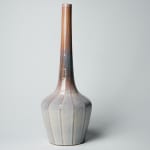Miyanohara Ken 宮之原 謙 Japanese, 1898-1977
H38.1 × Dia 14.2 cm
Further images
-
(View a larger image of thumbnail 1
)

-
(View a larger image of thumbnail 2
)

-
(View a larger image of thumbnail 3
)

-
(View a larger image of thumbnail 4
)

-
(View a larger image of thumbnail 5
)

-
(View a larger image of thumbnail 6
)

-
(View a larger image of thumbnail 7
)

-
(View a larger image of thumbnail 8
)

-
(View a larger image of thumbnail 9
)

-
(View a larger image of thumbnail 10
)

-
(View a larger image of thumbnail 11
)

-
(View a larger image of thumbnail 12
)

-
(View a larger image of thumbnail 13
)

-
(View a larger image of thumbnail 14
)

-
(View a larger image of thumbnail 15
)

-
(View a larger image of thumbnail 16
)

-
(View a larger image of thumbnail 17
)

-
(View a larger image of thumbnail 18
)

Born in 1898 in Kagoshima City, Miyanohara Ken was one of the most highly celebrated potters of his time. His work is well-respected and widely known among connoisseurs in Japan and South Korea, though an exhibition of his works in the West remains unrealized. His works defies easy categorization, as he mastered a range of styles during his lifetime, notably Chinese glazes such as Tenmoku, Jun glaze, and celadon over stoneware and porcelain.
After dropping out of Waseda University, after a brief engagement with architecture, Ken found himself in 1924 at the esteemed Kawabata School of Painting. Here, he delved into the realms of Japanese painting under the guidance of the eminent Takamon Yamanouchi, and honed his skills in ceramics through the mentorship of Kazan Miyagawa. Following this, he studied under one of the most highly celebrated potters in Modern Japanese ceramics alongside Yasuhara Kimei: Hazan Itaya.
In 1927, Ken played a pivotal role in the establishment of the Totokai. Shortly after, he won the inaugural prize at the prestigious 10th Teiten Exhibition with a breathtaking ceramic vase with bamboo form featuring an iron sand “Tessha” glaze. In a pursuit of holistic artistic enrichment, he also delved into the profound realm of Indian philosophy and Pure Land Buddhism, guided by the wisdom of Yusaburo Okakura.
Ken's artistic influence extended beyond personal achievements. In collaboration with Zodo Sasaki, he co-founded "Niigata Toen," where he shared his expertise in Koshiji ware, shaping the future of pottery. His commitment to the arts was further demonstrated through his role as a judge at postwar Nitten exhibitions, including the inaugural Bunten. Over the years, Ken's contributions to the world of art were duly recognized as he ascended the ranks within the Nitten organization. He assumed the role of Nitten Councilor in 1950, followed by Nitten Councilor in 1958, and ultimately achieved the esteemed position of Nitten Director in 1969.
During the peak of his career, in 1973, Ken was appointed as an advisor to Nitten, solidifying his enduring legacy in the art world. His journey stands as a testament to the spirit of an artist-craftsman, leaving an indelible mark on the world of Japanese ceramics.

















